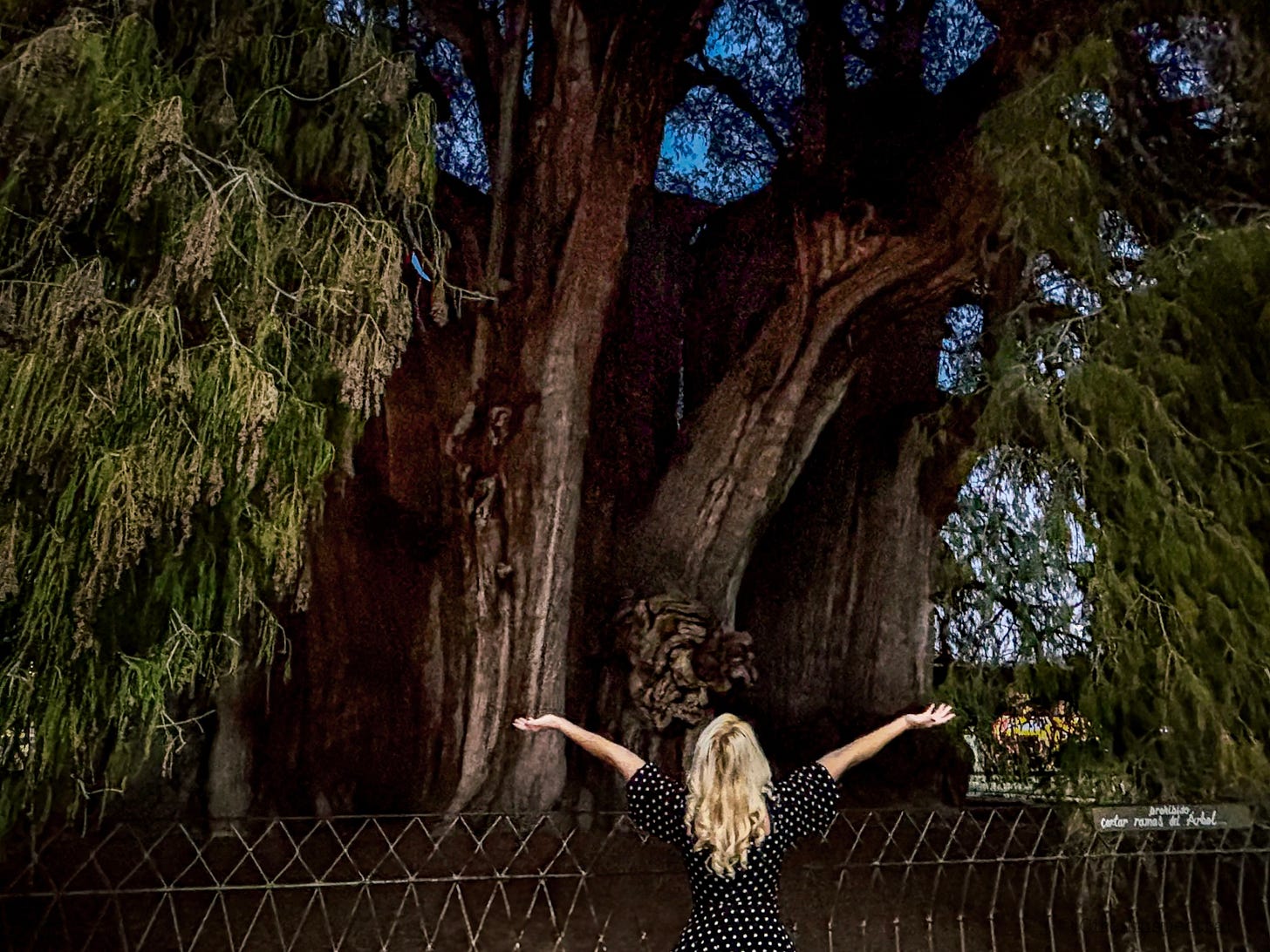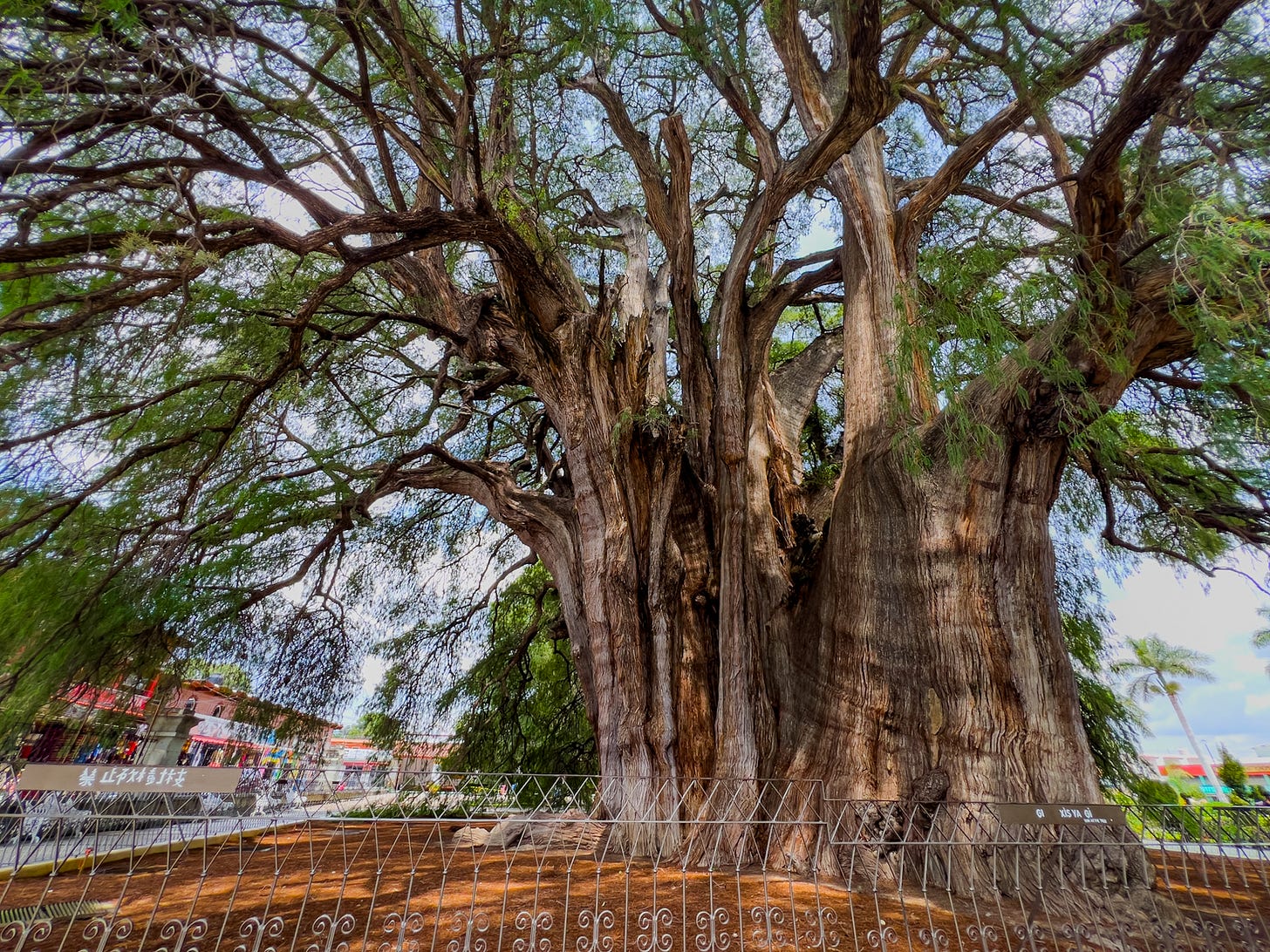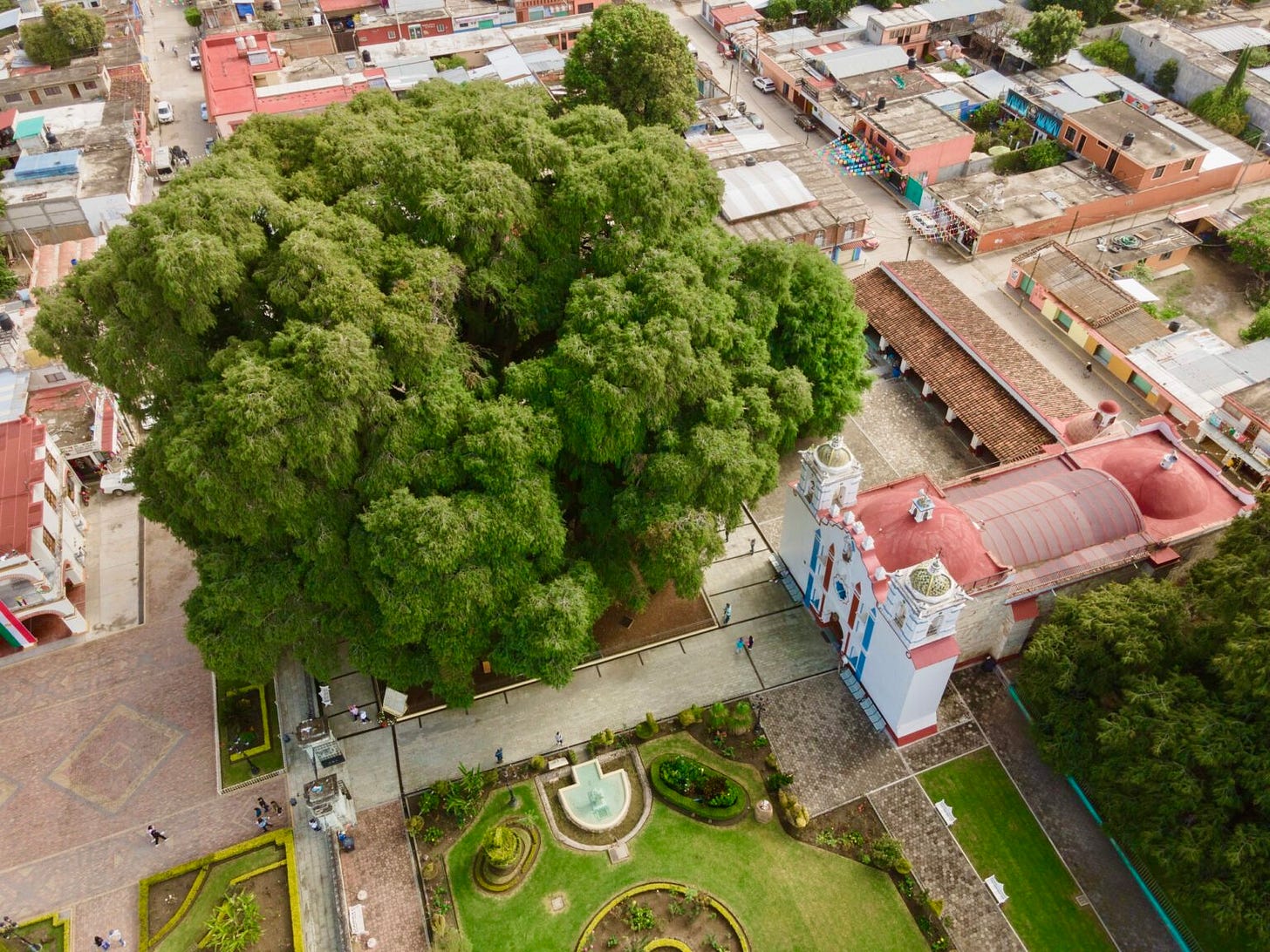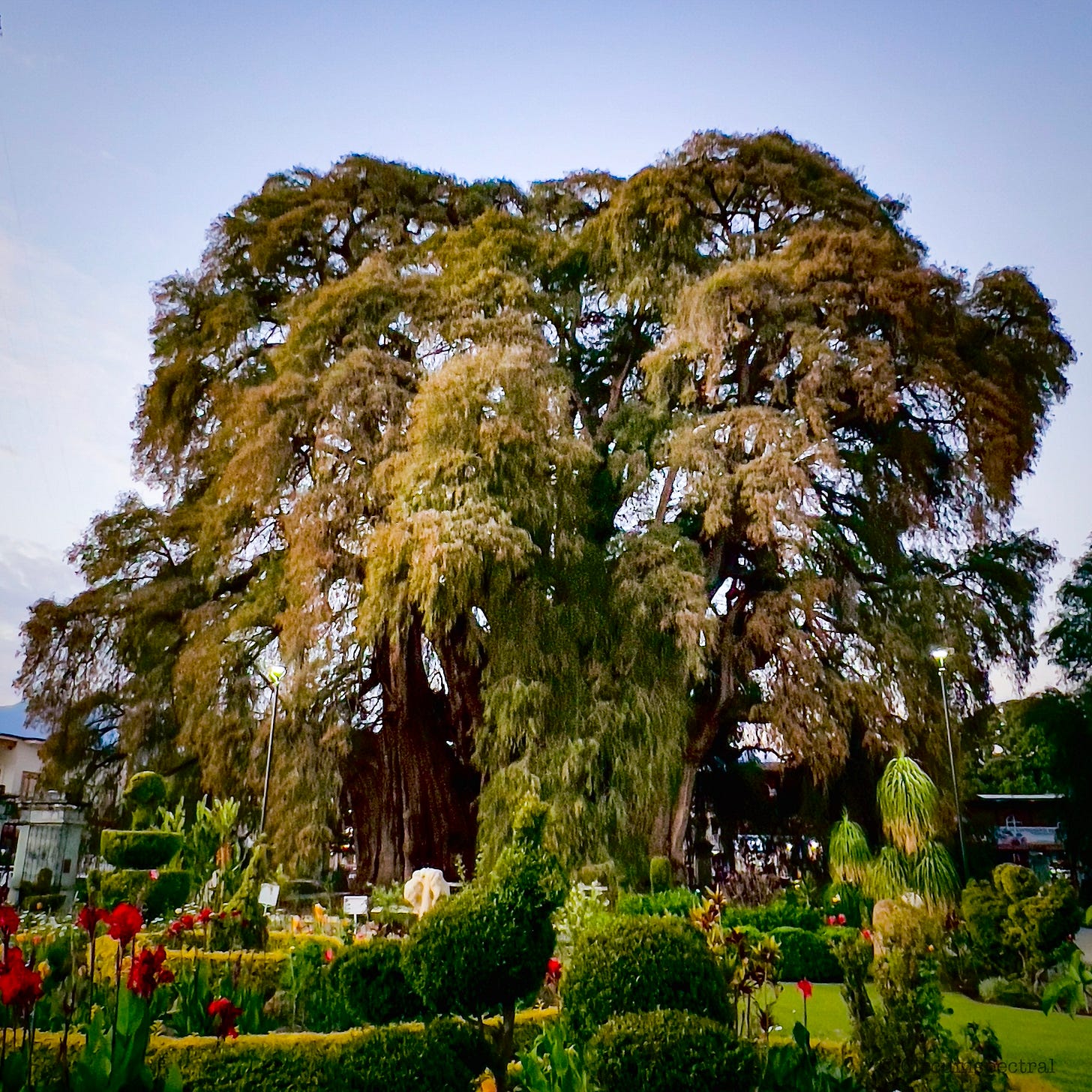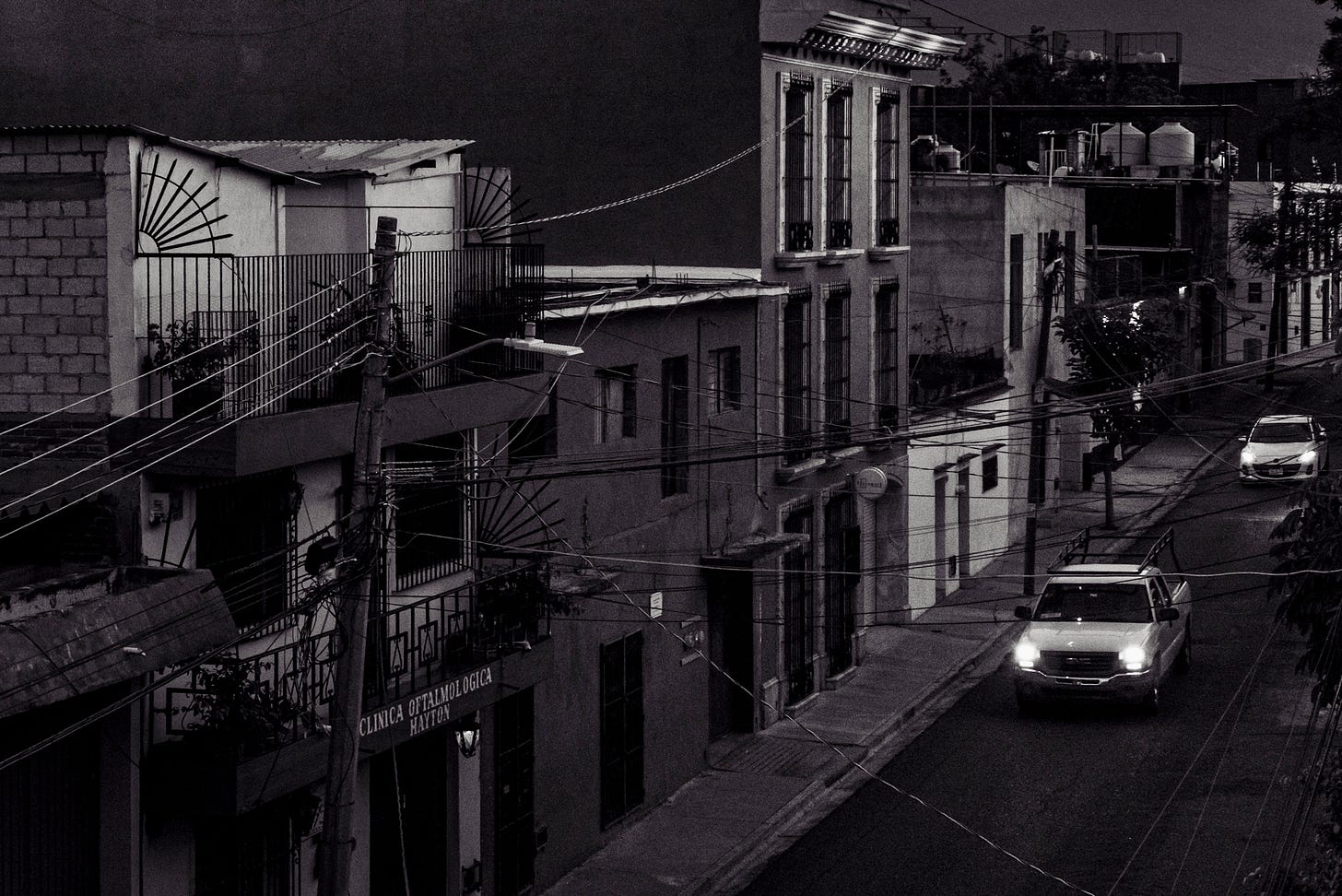“The travel book itself has a similar grab bag quality. It incorporates the characters and plot line of a novel, the descriptive power of poetry, the substance of a history lesson, the discursiveness of an essay, and the—often inadvertent—self-revelation of a memoir.”
-Thomas Swick “Not a Tourist." The Wilson Quarterly, Winter, 2010.
Oaxaca Oaxaca
Slower Than Time • Chapter 4
The Tree Of Life
Sometimes exploring the world, a small thing on your itinerary turns out to be a big thing. Perhaps it wasn’t on your itinerary; you went on a lark. And it takes your breath away, even as it’s pumping enormous amounts of oxygen into the air around you.
There’s a tree—a really big tree—a few miles to the east of Oaxaca and for us it was a revelation. One of those must-see postcard things which for a certain kind of seasoned traveller also means easily dismissed. With an admission fee, a fence around, and watchful staff. Yet somehow it overcomes these sad trappings and inspires an almost sacred sense of wonder. I was struck by that traveler’s paradox; the self-mocking nature of cash-generating tourist sites pitted against the feeling of awe they often inspire that sweeps all cynicism away. An explorer’s journey is full of such absurdities.
Reading about El Árbol del Tule from various sources online, its history, its dimensions, its future, one finds vagueness at every turn. Its age, for example. 800 years? 2000? A wild suggestion it might be 6000. Most scholars have settled on 1400, which takes us back to the early 600s (CE). This comports both with biological evidence and the surviving legends passed down by Zapotec oral tradition and writings, much now lost due to death and plunder after the many battles fought between indigenous civilizations and their would-be conquerers.
Also, alternate specs about its circumference (actual footprint vs. tape measure vs. how many adults it takes to form a peripheral ring-a-rosy, arms outstretched) and about its height (even after using laser levels). There’s dispute over whether it’s dying or not. It certainly must be stressed by the 8000 vehicles a day passing nearby on the Mitla highway. It even boasts two origin stories in Zapotec mythology. As if the ancient wind god Ehécatl, who blessed this tree at its planting, was sending a message forward through the centuries. About nature itself; how it also exists in a spiritual realm undefined by scientific exactitude. Mere mortals like us sometimes only need to be respectful and reverent.
This visit to Oaxaca was also an inner journey for me. A break from Calgary’s bleak lingering winter, sure, and the chance for a too-rare romantic revival with my darling—spiritual indeed, however brief. Perhaps as important, for my creative peace, I needed to break the icy shell of hiatus, and ignite the necessary spark that would get me publishing again. It was standing under the immense canopy of the Árbol that I finally saw a way forward.
El Tule’s ambiguities made me think of the contradictions inherent in travel writing itself; how it can be least interesting when it’s most descriptive. How authenticity and experience are often at odds depending on an author’s peeves and enthusiasms. How a scrupulously objective approach can lead to more questions than answers. These conundrums were just dawning on me two Januarys ago when I paused this newsletter. Although the break came more from a series of external crises, I knew I would need to re-visit those questions before resuming my articles.
On this particular visit in March 2025, the big tree entered my thinking only after we arrived in the city. A serendipitous memory of a postcard I’d received in the early nineties from an old workmate, a Newfoundland hippie slash sage named Alex, veteran vagabond of the old “gringo trail”, sleeping in his hammock, stashing travellers cheques in his money belt. It was a photo of dozens of schoolchildren standing under a massive tree. Greetings from Oaxaca!
It was right there on Google. A few kilometers away in a suburban village, Santa María del Tule. The day was getting late, but picture takers we were, and this might be a perfect time of slanting sunlight, the sky already shading purple. We haggled a taxi ride, dismissing one surly driver in favor of someone more amenable to our budget, and off we went.
To Tule, formerly quaint, now a continuation of the unplanned sprawl stretching east from Oaxaca, commercial and uninspired, with scattered plots of farmland behind. The driver found a place to stop, pointing vaguely northward. Only a short walk it turned out and only a few other visitors. Almost closing time. We paid the 20 pesos anyway. The air seemed suddenly and euphorically fresh. Was the tree creating its own nano-climate or was it blessed relief from being away from the city’s endlessly crawling traffic?
Surrounded by blue-green peaks and a glowing expanse of velvet sundown sky, the setting was a broad plaza of paving stones and horticulturally-precise gardens behind black iron fences. At one end of a wide boulevard, empty of cars and kiosks, enterprise only in the tidy shops, all of them selling mezcal on the side, regardless of their stated purpose. The effect, only a couple of hundred meters from the messy main drag was orderly and almost antiseptic, not typically Mexican.
Even so, at the centre of this vast tranquil acreage, they’d chosen to clog the space near the main attraction, A municipal building and a church on opposite sides, practically touching the canopy. A low protective fence only meters from the trunk inside a slightly larger compound also fenced with black iron between bricked pillars. One gateway to herd visitors in and out. Human interference bordering on arrogance, so often the case, not happy to let something wonderful and natural alone.
Yet the Tree of Life abides, reaching up and out to find breathing room, its limber lower branches almost touching the earth, thick with leaves, honoring gravity. (File photo above.)
I had first approached Circumspectral looking to display my pictures, collected over twenty years. For myself and then an audience if there was interest. From Asia, Central America, the American West, Spain, Canada and several trips all over Mexico. Visual essays, by location or theme, captioned for context, just a paragraph or two, as witty and thoughtful as I could manage. With companion articles offering bursts of wisdom to others meandering the world in a similar mode: overland, unstructured, managing a budget, but rich in the boundless luxuries of movement and time.
Then my inner storyteller stepped forward. Why not more prose between pictures? I was seething with narratives if I could get them sorted. Vivid encounters, myriad surprises, too many mishaps to count. I had seen some shit. My authorial goals grew more lofty. Yet the result, those first issues, were an ungainly kludge of several impulses. Part gallery, part guide, part journal. It felt shallow. A surface skim based on foggy recollections from years ago.
I wonder if this yen I have for travel is born more from restlessness than curiosity, of feeling trapped in the over-familiar, a psychic prison of artistic frustration. especially if moods are souring and doors are closing on the home front. My career surveying the boreal forests of Canada, isolated for weeks at a time with only bare essentials—camp food, camp lodging, insulated coveralls—an unchanging routine stuck in a winter world of men, always left me starved for release after we wrapped up the season. I needed days to myself. Itineraries of my own choosing. There’s no freedom quite like lifting off a runway or driving out a road beyond, to begin weeks or months of underplanned adventure.
My commitment to a written record of my travels never amounted to more than dutifully buying a coil-ringed exercise book at a proper stationery store before each trip and then abandoning the effort after a few perfunctory notations, using the remaining sheets as scratch pads for calculating the next stop’s budget. That ominous blank page. Even the prospect of mailing a postcard could inspire dread.
My mental energies were funneled into pictures instead. Photography! Stepping out into honey-tipped mornings or the silted glow of twilight, even mid-afternoon some days under a blazing documentary sun down unkempt streets, hoping to finish the day with three or five or ten new snaps I could claim as keepers, feeling lucky if even one was portfolio ready. My research was strictly prosaic; rooms, transport, feats of architecture and scenic wonders, never plunging too deeply into a region’s culture and history—damn it, Jim, I’m a bush worker, not a scholar! So a reset was going to be necessary once I made my relaunch as an aspiring travel writer. More immediacy, more depth and, if you can stand it, more personal reflection.
In this quest for gravitas, I’ve turned recently to a pantheon of known authors, travel specialists, practitioners of a deep tradition going back centuries. Not only the writers, but the people who write about travel writers as well (and here’s me writing about the people who write about travel writers—feel free to write about me) who critique these efforts, often inordinately concerned about authenticity, an ephemeral notion at best.
Who best travels how? In this discourse, mere tourists are the least evolved of the species, two-week punters wrangled by guides on a strict schedule. But it’s not for me to judge. We are all tourists at some level. The beaten path is often the best place to be as we pause to get our bearings. I’m developing opinions as I compare my own perceptions and discoveries against these literary stalwarts. I hope to write a bit about the books I’ve read in future issues.
Not much to do in the waning minutes but stand and stare at this staunch survivor, humbled under the sheer bulk of its base. The size of a small house, or should I say condominium, as hundreds of sparrows were flying in and out of their little hidey-hole homes up and down the trunk.
It is a Montezuma cypress (Taxodium mucronatum), or ahuehuete, meaning "old man of the water" in Nahuatl). There are other ancient cypress in small stands along the Sierra, but this is by far the largest, measuring almost 42 meters around. Nearly 40 meters tall and estimated to weigh 636 tons. It was once thought to be multiple trees, but tests have concluded that it is only one tree. I was good with that.
We made our pictures, selfies and poses too, so glad we came, refreshed finally after the disruptions and dislocations that had brought us together, then strolled up the road to a terrace restaurant open for supper, where we could watch the wall of leaves down the block get swallowed by the night.
Back at the highway, flagging a cab was merely formal, as four or five swooped in at once, alert in the shadows for a sudden appearance of stranded tourists. The fares were all over the map ranging from ridiculous to a little more than we paid to get here. Then a honk from the guy at the back of the line, shouting from the window. “Cien!” Cien? Did I hear that right? It seemed low. “Si! Si! One hundred.” He spoke English. “I am going back anyway.” I liked his spirit. We climbed in the back.
He was a chatty guy. A friendly oddball. I asked where he learned English.
“Pennsylvania. I worked construction. Framing. Drywall.”
“Under the table?” None of my business, but I asked anyway.
“Oh, yes”
I wanted to know how he crossed the border, the danger, the uncertainty, but thought maybe I shouldn’t ask too much, not in these times.
“But now you’re back.”
“Yes. I tried to go to Canada. Niagara Falls.”
“Really? I’m from Canada. They can be strict.”
“Si. They said I needed more money. I have a friend in Montreal. Said I could work there. But they turned me around. I didn’t want to go to the states again, so I went to Mexico City.”
A strange story, full of intriguing gaps. This is a common tale, told to me several times already by men of a certain age here, eager to practice their English with an obvious gringo. A rite of passage almost, laboring somewhere in the US, then returning for family reasons.
“I drove a taxi there too, but I was robbed three times. They pointed a gun at me. So I came back here. This is where I’m from. My parents are here.”
We were close. He was telling us he’d applied to a bus company, then things went sideways. Was that our hotel? These dark streets. I pulled out my phone. Sure enough. He’d blown right past it. We were two blocks further by then. It’s ok, drop us here. But no, he pushed the cab forward, turning left and left again, hitting a T and turning right. He was flailing, zigzagging through these tight one-way streets, making us dizzy. Left. Right. A church wall that went for blocks. Another left. There! Our hotel! I opened my door as he approached the corner. For encouragement. We’re here. He lurched to the curb. I handed him the fare. We were free.
Back in the world of people after communing with ancient gods, deflated and disoriented, dropped in the shadows outside our hotel. I walked my darling to the room and told her I’d be right back. There was a florist on the corner. I bought a single flower. The promise of tomorrow. Greetings from Oaxaca!
(End of Chapter Four)
*Thank you for reading Oaxaca Oaxaca. I came back here in June with new energy and plans to re-boot Circumspectral as an up to the moment travel blog, with stories from my travels ahead (and a few trips already taken.) This means being an assiduous note-taker as well as a photographer. And a more efficient editor as I compose, correct, format and illustrate. If you can allow for the time it takes to do this properly, these dispatches will be as current as possible.
*This is a personal project, not a business venture, but please consider entering your name in the subscriber box. Writers love a sense of validation.
Always free of charge.





